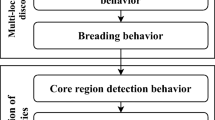Abstract
To cope with the difficulty of MRI brain scans automatic segmentation, we need to constrain and control the selection and the adjustment of processing tools depending on the local image characteristics. To extract domain and control knowledge from the image, we propose to use situated cooperative agents whose dedicated behavior, i.e. segmentation of one type of tissue, is dynamically adapted with respect to their position in the image. Qualitative maps are used as a common framework to represent knowledge. Constraints that drive the agents behavior, based on topographic relationships and radiometric information, are gradually gained and refined during the segmentation progress. Incremental refinement of the segmentation is obtained through the combination, distribution and opposition of solutions concurrently proposed by the agents, via respectively three types of cooperation: integrative, augmentative and confrontational. We report in detail our multi-agent approach and results obtained on MRI brain scans.
Preview
Unable to display preview. Download preview PDF.
Similar content being viewed by others
References
Zeki, S. and Shipp, S.: The functional logic of cortical connections. Nature 335 (1988) 311–314.
Tootell, R. B., Hadjikhani, N. K., Mendola, J. D., et al.: From retinotopy to recognition: fMRI in human visual cortex. Trends Neurosci 2 (1998) 174–182.
Van Essen, D. C., Drury, H. A., Joshi, S. et al.: Functional and structural mapping of human cerebral cortex: solutions are in the surfaces. PNAS USA 95 (1998) 788–795.
Wandell, B. A.: Computational neuroimaging of human visual cortex. Ann Rev Neurosci 22 (1999) 145–173.
DeYoe, E. A., Carman, G. J., Bandettini, P., et al.: Mapping striate and extrastriate visual areas in human cerebral cortex. PNAS USA 93 (1996) 2382–86.
Wandell, B. A., Chial, S. and Backus, B. T.: Visualization and measurement of the cortical surface. Journal of Cognitive Neuroscience 12 (2001) 739–752.
Teo, P. C., Sapiro, G. and Wandell, B. A.: Creating connected representations of cortical gray matter for functional MRI visualization. IEEE Trans Med Imag 16 (1997) 852–863.
Collins, D., Zijdenbos, A., Kollokian, V., et al.: Design and construction of a realistic digital brain phantom. IEEE Trans Med Imag 17 (1998) 463–468.
Drury, H. A., Van Essen, D. C., Anderson, C. H., et al.: Computerized mappings of the cerebral cortex: a multiresolution flattening method and a surface-based coordinate system. Journal of Cognitive Neuroscience 8 (1996) 1–28.
Dale, A. M., Fischl, B. and Sereno, M.: Cortical surface-based analysis I: segmentation and surface reconstruction. NeuroImage 9 (1999) 179–194.
Germond, L., Dojat, M., Taylor, C. and Garbay, C.: A cooperative framework for segmentation of MRI brain scans. Artif Intell in Med 20 (2000) 77–94.
Warnking, J., Guérin-Dugué, A., Chéhikian, A., et al.: Retinotopical mapping of visual areas using fMRI and a fast cortical flattening algorithm. Neuroimage 11 (2000) S646.
Bloch, I.: Information combination operators for data fusion: A comparative review with classification. IEEE Trans Systems, Man, Cybernetics 26 (1996)
Comaniciu, D. and Meer, P.: Distribution free decomposition of multivariate data. Pattern analysis applications 2 (1999) 22–30.
Author information
Authors and Affiliations
Editor information
Editors and Affiliations
Rights and permissions
Copyright information
© 2001 Springer-Verlag Berlin Heidelberg
About this paper
Cite this paper
Richard, N., Dojat, M., Garbay, C. (2001). Dynamic Adaptation of Cooperative Agents for MRI Brain Scans Segmentation. In: Quaglini, S., Barahona, P., Andreassen, S. (eds) Artificial Intelligence in Medicine. AIME 2001. Lecture Notes in Computer Science(), vol 2101. Springer, Berlin, Heidelberg. https://doi.org/10.1007/3-540-48229-6_48
Download citation
DOI: https://doi.org/10.1007/3-540-48229-6_48
Published:
Publisher Name: Springer, Berlin, Heidelberg
Print ISBN: 978-3-540-42294-5
Online ISBN: 978-3-540-48229-1
eBook Packages: Springer Book Archive




